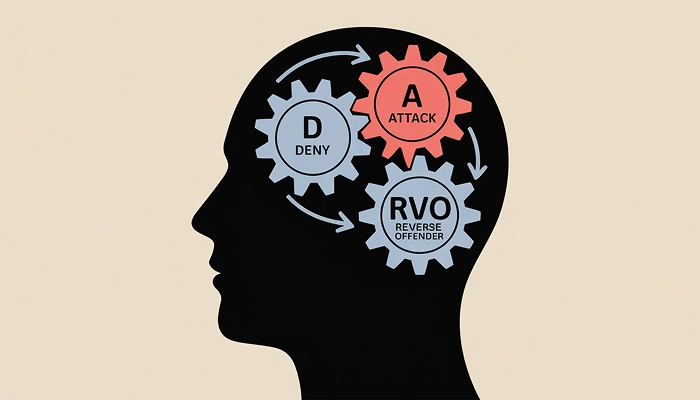Have you ever confronted someone about being hurt, only to have them turn the tables—denying it, accusing you, or claiming they’re the real victim?
“You’re so sensitive. Stop being dramatic.”
“That never happened.”
“Actually, I AM the one who’s been hurt here.”
If these phrases sound familiar, you may have encountered a manipulation tactic that mental health professionals call DARVO. This type of communication is a way of controlling another person by manipulating, evading It’s distressing and disorienting—and it makes you doubt your own memory or sense of what happened.
The good news is – once you recognize it, you can’t unsee it.
In this article, we’ll break down DARVO, explain how it works, show its mental health toll, and suggest practical, compassionate steps on what to do and how to respond to the manipulator. If you or someone you care about has been silenced or gaslit, you’re not alone—and understanding DARVO is one step toward reclaiming your voice and supporting your mental well-being.
What Is DARVO?
DARVO is an acronym for manipulative communication: Deny, Attack, Reverse Victim and Offender. Coined by psychologist Jennifer Freyd in the 1990s, DARVO describes how individuals may evade accountability when confronted with their wrongdoings.
DARVO combines elements of gaslighting and blame-shifting. Instead of addressing the issue, perpetrators deny the facts, attack the accuser, and position themselves as the true victim while portraying the original victim as the aggressor.
DARVO is more than just “someone overreacting”—it’s a calculated narrative shift often used by people who benefit from not being held accountable. It serves to:
- Evade responsibility,
- Maintain power and control,
- Discredit the person raising the alarm,
- Centralize sympathy and attention back on the perpetrator.
Although DARVO was first studied in the context of interpersonal violence and sexual misconduct, today it is recognized in many contexts – intimate relationships, workplaces, institutions, and even public scandals.

How the DARVO Manipulation Works
DARVO is so powerful because it exploits common psychological vulnerabilities – confusion, guilt, shame, and fear of being disbelieved.
The perpetrator usually follows these 3 steps:
Step 1: Deny
| Characteristics | Example |
| Refusing to acknowledge the issue. | “That never happened. You’re making this up.” |
| Minimizing the harm. | “It’s not that serious. It was just a joke.” |
| Reframing the narrative without providing specifics. | “You’re taking what I said completely out of context. Stop exaggerating.” |
| Using selective memory. | “I don’t recall saying anything hurtful to you during that conversation.” |
Step 2: Attack
| Characteristics | Example |
| Questioning the victim’s character. | “This is so you. It wouldn’t be the first time you’re being dramatic.” |
| Attacking the victim’s credibility. | “We all know your memory is terrible. You’re getting this wrong, too.” |
| Deflecting to unrelated issues. | “You’re the one to talk about compassion! Remember when you forgot my birthday?” |
Step 3: Reverse Victim and Offender
| Characteristics | Example |
| Claiming to be the real victim. | “I can’t believe you’d attack me after all I have sacrificed for you.” |
| Portraying the accuser as the aggressor. | “You’re the one who chooses to cause drama and hurt me with these baseless accusations.” |
| Creating false equivalence. | “You built walls and became distant, so we’re both closed off and emotionally unavailable.” |
The Effects of DARVO on Mental Health
DARVO doesn’t just hurt in the moment—it can linger long-term, leaving deep emotional effects.
- People who’ve been “DARVO’d” often find themselves living with a knot of anxiety that’s hard to loosen, constantly scanning for danger, second-guessing their every word and action, tiptoeing through their own life, trying not to set someone off. That constant state of alert can eventually result in chronic anxiety.
- Research points to a direct relationship between exposure to DARVO and increased self-blame among victims [1] – the more DARVO tactics a perpetrator uses during confrontation, the more victims report feeling responsible for the wrongdoing committed against them.
- This self-blame is particularly damaging because it is associated with more psychological distress [2], maladaptive coping mechanisms, and post-traumatic stress disorder symptoms .
- Depression – another significant consequence – can make victims struggle with feeling emotionally drained, hopeless, and powerless after ongoing manipulation. Sometimes, they might even develop major depressive disorder characterized by persistent sadness, feeling worthless, and losing interest in activities which they used to enjoy beforehand.
- Perhaps most insidiously, DARVO warps victims’ perception of reality [3], leading them to internalize false narratives that they are the perpetrators, causing confusion, dissociation, derealization, and a complete loss of their sense of self and boundaries.

How to Respond to DARVO
Recognizing DARVO is key—look for denial without remorse, personal attacks, and role flips driven by emotion. Here’s how to respond effectively:
Document Your Experience |
Record your version soon after events—dates, phrases, witnesses. This helps anchor you to your experience.
Amid gaslighting, this can be your voice of reason. |
Set Firm Boundaries |
Use a simple, consistent phrasing like:
Avoid engaging in the attacks. Recognize they are manipulative. Give yourself emotional permission not to push back. Distance yourself if needed, like limiting contact with toxic family members. |
Avoid Role Reversal |
Recognize you don’t need to answer insults, accusations, or deflections.
Stick to facts with the “broken record” technique—calmly and consistently restate the facts from your perspective without getting drawn into side arguments. |
Prioritize Creating Emotional, Mental & Physical Safety |
Sometimes, stepping away from conflict is less about avoidance and more about turning your attention toward routines that bring steadiness and comfort.
Engaging in grounding habits—such as mindfulness practice, movement, or journaling about your experiences—can help you stay centered in what feels true for you, even when others try to distort your reality. |
Seek Support |
Lean on trusted friends or family for validation – they can reinforce your clarity and offer needed perspective.
Remind yourself, “I deserve respect.” |
Educate Yourself& Others |
When possible, sharing information about DARVO (and having others witness or validate your experience) can blunt and mitigate its influence.
Some experimental research suggests that educating observers about DARVO reduces its effectiveness [3]. |

Get Professional Help With Harbor Psychiatry and Mental Health
DARVO thrives on isolation—it’s designed to make you doubt yourself, withdraw from others, and question your reality…
That’s why reaching out for professional psychological support isn’t just beneficial – it’s essential. Psychotherapy offers a safe, validating space where you can:
- Process confusion & guilt or shame,
- Rebuild self-trust,
- Focus on strengthening psychological resilience.
A skilled therapist from our team of providers can guide you in identifying manipulation patterns, setting and maintaining healthy boundaries, and reconnecting with people who genuinely support you. Through this process, your sense of safety, clarity, and self-worth can gradually be restored.
If you’ve been feeling alone or disoriented after being manipulated, know that help is available. Reach out today to take the first step toward healing—you don’t have to do it by yourself.
Healing begins with support, and you don’t have to walk this path alone.
References:
[1] Harsey, S. J., Zurbriggen, E. L., & Freyd, J. J. (2017). Perpetrator Responses to Victim Confrontation: DARVO and Victim Self-Blame. Journal of Aggression, Maltreatment & Trauma, 26(6), 644–663.
[2] Harsey, S. J., & Freyd, J. J. (2023). The influence of deny, attack, reverse victim and offender and insincere apologies on perceptions of sexual assault. Journal of Interpersonal Violence. Advance online publication.
[3] Harsey, S., & Freyd, J. J. (2020). Deny, Attack, and Reverse Victim and Offender (DARVO): What Is the Influence on Perceived Perpetrator and Victim Credibility? Journal of Aggression, Maltreatment & Trauma, 29(8), 897–916.



